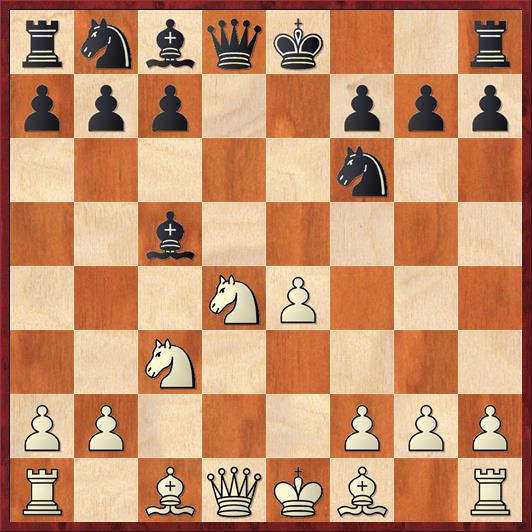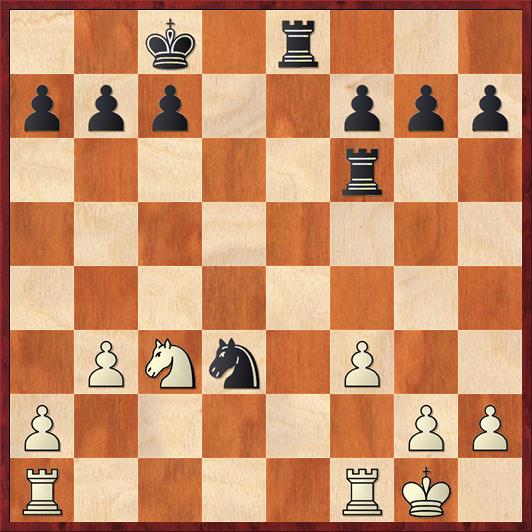Last night I won my third-round game in the Kolty Chess Club championship. While last week’s game was short and invigorating, this game was more like waiting for paint to dry. I was paired against Anika Rajaram, who is the fourth-rated 11-year-old girl (and 54th 11-year-old overall) in the nation.
I played my usual Marshall Defense (1. d4 Nf6 2. c4 d5) and she was not very well prepared for it. She lost a pawn on move 9; it’s hard to say whether it was an intentional sacrifice or a blunder, but she didn’t follow it up very well. By move 24 I had traded into a pawn-up knight and pawn endgame, and after that it was just grind, grind, grind.
Here are really the only two interesting moments in the game.

FEN: rnbqk2r/ppp2ppp/5n2/2b5/3NP3/2N5/PP3PPP/R1BQKB1R w KQkq – 0 8
In the first position, White should continue with the natural 8. Be3 Qe7 etc., which Rybka rates as equal. It seemed as if maybe she was going to play that but changed her mind at the last moment and played 8. Nb3?! instead. If this was an intentional pawn sacrifice, I think it might have been somewhat interesting. I played 8. … Qxd1+ 9. Nxd1 Nxe4, of course. If she had followed up with 10. Nxc5 Nxc5 11. Be3, White definitely gets some compensation for the pawn because of her superior development and two bishops in an open position. I was aware of this but willing to slog it out.
However, she followed up with the much weaker 11. Bb5+? Bd7! 12. Bxd7+ Nxd7, after which I had no worries at all. My development is superior and she no longer has the two bishops, and I still have a very healthy extra pawn.

FEN: 2k1r3/ppp2ppp/5r2/8/8/1PNn1P2/P5PP/R4RK1 b – – 0 19
Here is the second interesting moment. She has just played 19. Nc3 and is threatening to finally untangle her position with Rad1, Ne4, etc. The natural-looking move is 19. … R6e6 and I’m sure it’s okay, but it didn’t seem on point to me because she is able to evict my beautiful knight with 20. Rad1. I really wanted to keep my knight on d3, so I played 19. … Rc6! instead, and I’m happy to see that Rybka agrees that it’s the best move.
As I had hoped, Rajaram played 20. Nb5, trying to gain time with the threat of a fork on a7, but I played 20. … Rc2, offering a pawn sac. I really liked this move, because I get an overwhelming attack on either 21. Nxa7+? Kb8 22. Nb5 R8e2 with mate to follow, or 21. Rfd1? Nf4 22. g3 Nh3+. But White does have a good way out, which Rajaram found: 21. Nd4! Rd2 22. Rfd1. Here I didn’t see anything better than liquidating the rooks with 22. … Rxd1+ 23. Rxd1 Re1+ 24. Rxe1 Nxe1, so that’s what I played.
I felt a little bit guilty playing this line because I felt as if I hadn’t realized the full potential of Black’s position. All I did was trade my two active rooks for White’s two passive rooks. On the other hand, I think that the knight endgame is simply won, so from a practical point of view there was nothing wrong with my decision.
I was curious to see what Rybka would think, and indeed the computer does find a little trick that changes the game to a complete rout. Rybka says that I should play 20. … Rc5! instead, putting the question to the knight right away. Now, after (say) 21. a4 a6 22. Nd4 Rd5, I get everything I wanted: my knight stays on d3, and my other rook will invade on e2. Rybka’s evaluation is +2.5 pawns in my favor, compared to about +1.25 for the other line.
Anyway, I was glad that I was able to win the grind-it-out endgame after 24. … Nxe1 without any screw-ups. Rajaram played all the way to checkmate, which was unusual at this level. But I always tell my students to play to mate, so I didn’t mind. I got to practice my mating technique with two queens.
After three rounds, I have 2½ points (two wins and a bye). There are four rounds to go. The early rounds are somewhat nerve-wracking because you are playing against people whom you’re “supposed” to beat. If you beat them, you get almost no rating reward, and if you draw or lose it’s a catastrophe. I’m relieved to be past that phase of the tournament, but now there is going to be some tough chess ahead.


